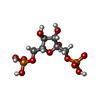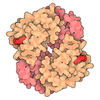[English] 日本語
 Yorodumi
Yorodumi- PDB-9r3h: Structure of liver pyruvate kinase in complex with fluorescent pr... -
+ Open data
Open data
- Basic information
Basic information
| Entry | Database: PDB / ID: 9r3h | ||||||
|---|---|---|---|---|---|---|---|
| Title | Structure of liver pyruvate kinase in complex with fluorescent probe 4b | ||||||
 Components Components | Isoform L-type of Pyruvate kinase PKLR | ||||||
 Keywords Keywords | TRANSFERASE / Pyruvate kinase / fluorescence / allosteric site | ||||||
| Function / homology |  Function and homology information Function and homology informationpyruvate kinase complex / pyruvate biosynthetic process / SARS-CoV-1-host interactions / ChREBP activates metabolic gene expression / pyruvate kinase / pyruvate kinase activity / Pyruvate metabolism / monosaccharide binding / Glycolysis / response to metal ion ...pyruvate kinase complex / pyruvate biosynthetic process / SARS-CoV-1-host interactions / ChREBP activates metabolic gene expression / pyruvate kinase / pyruvate kinase activity / Pyruvate metabolism / monosaccharide binding / Glycolysis / response to metal ion / response to ATP / Regulation of gene expression in beta cells / potassium ion binding / response to cAMP / response to glucose / response to nutrient / cellular response to epinephrine stimulus / glycolytic process / cellular response to insulin stimulus / kinase activity / response to hypoxia / magnesium ion binding / extracellular exosome / ATP binding / cytoplasm / cytosol Similarity search - Function | ||||||
| Biological species |  Homo sapiens (human) Homo sapiens (human) | ||||||
| Method |  X-RAY DIFFRACTION / X-RAY DIFFRACTION /  SYNCHROTRON / SYNCHROTRON /  MOLECULAR REPLACEMENT / Resolution: 2.1 Å MOLECULAR REPLACEMENT / Resolution: 2.1 Å | ||||||
 Authors Authors | Bogucka, A. / Nilsson, O. / Grotli, M. / Hyvonen, M. | ||||||
| Funding support |  United Kingdom, 1items United Kingdom, 1items
| ||||||
 Citation Citation |  Journal: Eur.J.Med.Chem. / Year: 2025 Journal: Eur.J.Med.Chem. / Year: 2025Title: Fluorescent binding assay for allosteric ligands of liver pyruvate kinase. Authors: Nilsson, O. / Bogucka, A. / Koteles, I. / Haversen, L. / Liljenberg, S. / Rutberg, M. / Hyvonen, M. / Grotli, M. | ||||||
| History |
|
- Structure visualization
Structure visualization
| Structure viewer | Molecule:  Molmil Molmil Jmol/JSmol Jmol/JSmol |
|---|
- Downloads & links
Downloads & links
- Download
Download
| PDBx/mmCIF format |  9r3h.cif.gz 9r3h.cif.gz | 717.9 KB | Display |  PDBx/mmCIF format PDBx/mmCIF format |
|---|---|---|---|---|
| PDB format |  pdb9r3h.ent.gz pdb9r3h.ent.gz | Display |  PDB format PDB format | |
| PDBx/mmJSON format |  9r3h.json.gz 9r3h.json.gz | Tree view |  PDBx/mmJSON format PDBx/mmJSON format | |
| Others |  Other downloads Other downloads |
-Validation report
| Summary document |  9r3h_validation.pdf.gz 9r3h_validation.pdf.gz | 5.1 MB | Display |  wwPDB validaton report wwPDB validaton report |
|---|---|---|---|---|
| Full document |  9r3h_full_validation.pdf.gz 9r3h_full_validation.pdf.gz | 5.1 MB | Display | |
| Data in XML |  9r3h_validation.xml.gz 9r3h_validation.xml.gz | 168.6 KB | Display | |
| Data in CIF |  9r3h_validation.cif.gz 9r3h_validation.cif.gz | 224 KB | Display | |
| Arichive directory |  https://data.pdbj.org/pub/pdb/validation_reports/r3/9r3h https://data.pdbj.org/pub/pdb/validation_reports/r3/9r3h ftp://data.pdbj.org/pub/pdb/validation_reports/r3/9r3h ftp://data.pdbj.org/pub/pdb/validation_reports/r3/9r3h | HTTPS FTP |
-Related structure data
| Related structure data |  9r3iC  9r3lC  9r3mC  9r3oC C: citing same article ( |
|---|---|
| Similar structure data | Similarity search - Function & homology  F&H Search F&H Search |
- Links
Links
- Assembly
Assembly
| Deposited unit | 
| ||||||||
|---|---|---|---|---|---|---|---|---|---|
| 1 | 
| ||||||||
| 2 | 
| ||||||||
| Unit cell |
|
- Components
Components
-Protein / Sugars , 2 types, 16 molecules ABCDEFGH

| #1: Protein | Mass: 48285.379 Da / Num. of mol.: 8 Source method: isolated from a genetically manipulated source Source: (gene. exp.)  Homo sapiens (human) / Gene: PKLR, PK1, PKL / Production host: Homo sapiens (human) / Gene: PKLR, PK1, PKL / Production host:  #2: Sugar | ChemComp-FBP / |
|---|
-Non-polymers , 5 types, 2279 molecules 






| #3: Chemical | ChemComp-OXL / #4: Chemical | ChemComp-MG / #5: Chemical | ChemComp-K / #6: Chemical | ChemComp-A1JB3 / Mass: 455.465 Da / Num. of mol.: 4 / Source method: obtained synthetically / Formula: C16H17N5O7S2 / Feature type: SUBJECT OF INVESTIGATION #7: Water | ChemComp-HOH / | |
|---|
-Details
| Has ligand of interest | Y |
|---|---|
| Has protein modification | N |
-Experimental details
-Experiment
| Experiment | Method:  X-RAY DIFFRACTION / Number of used crystals: 1 X-RAY DIFFRACTION / Number of used crystals: 1 |
|---|
- Sample preparation
Sample preparation
| Crystal | Density Matthews: 2.88 Å3/Da / Density % sol: 57.22 % |
|---|---|
| Crystal grow | Temperature: 291 K / Method: vapor diffusion, hanging drop / pH: 7.5 Details: 100 mM HEPES/MOPS, 10% PEG8000, 20% ethylene glycol, 10 mM phenylalanine, 20 mM sodium oxalate |
-Data collection
| Diffraction | Mean temperature: 100 K / Serial crystal experiment: N | ||||||||||||||||||||||||||||||||||||||||||||||||||||||||||||||||||||||||||||||||||||||||||||||||||||||||||||||||||||||||||||||||||||||||||||||||||||||||||||||||||||||||||||||||||||||||||||||||||||||||||||||||||||||||||||||||||||||||||||||||||||||||||||||||||||||||||||||||||||||||||||||||||||||||||||||||||||||||||||||||||||||||||||||||||||||||||||||||||||||||||||||||||||||||||||||||||||||||||||||||||||||||||||||||||||||
|---|---|---|---|---|---|---|---|---|---|---|---|---|---|---|---|---|---|---|---|---|---|---|---|---|---|---|---|---|---|---|---|---|---|---|---|---|---|---|---|---|---|---|---|---|---|---|---|---|---|---|---|---|---|---|---|---|---|---|---|---|---|---|---|---|---|---|---|---|---|---|---|---|---|---|---|---|---|---|---|---|---|---|---|---|---|---|---|---|---|---|---|---|---|---|---|---|---|---|---|---|---|---|---|---|---|---|---|---|---|---|---|---|---|---|---|---|---|---|---|---|---|---|---|---|---|---|---|---|---|---|---|---|---|---|---|---|---|---|---|---|---|---|---|---|---|---|---|---|---|---|---|---|---|---|---|---|---|---|---|---|---|---|---|---|---|---|---|---|---|---|---|---|---|---|---|---|---|---|---|---|---|---|---|---|---|---|---|---|---|---|---|---|---|---|---|---|---|---|---|---|---|---|---|---|---|---|---|---|---|---|---|---|---|---|---|---|---|---|---|---|---|---|---|---|---|---|---|---|---|---|---|---|---|---|---|---|---|---|---|---|---|---|---|---|---|---|---|---|---|---|---|---|---|---|---|---|---|---|---|---|---|---|---|---|---|---|---|---|---|---|---|---|---|---|---|---|---|---|---|---|---|---|---|---|---|---|---|---|---|---|---|---|---|---|---|---|---|---|---|---|---|---|---|---|---|---|---|---|---|---|---|---|---|---|---|---|---|---|---|---|---|---|---|---|---|---|---|---|---|---|---|---|---|---|---|---|---|---|---|---|---|---|---|---|---|---|---|---|---|---|---|---|---|---|---|---|---|---|---|---|---|---|---|---|---|---|---|---|---|---|---|---|---|---|---|---|---|---|---|---|---|---|---|---|---|---|---|---|---|---|---|---|---|---|---|---|---|---|---|---|---|---|---|---|---|---|---|---|---|---|---|---|---|---|---|---|---|---|---|---|---|---|---|
| Diffraction source | Source:  SYNCHROTRON / Site: SYNCHROTRON / Site:  Diamond Diamond  / Beamline: I04 / Wavelength: 0.95374 Å / Beamline: I04 / Wavelength: 0.95374 Å | ||||||||||||||||||||||||||||||||||||||||||||||||||||||||||||||||||||||||||||||||||||||||||||||||||||||||||||||||||||||||||||||||||||||||||||||||||||||||||||||||||||||||||||||||||||||||||||||||||||||||||||||||||||||||||||||||||||||||||||||||||||||||||||||||||||||||||||||||||||||||||||||||||||||||||||||||||||||||||||||||||||||||||||||||||||||||||||||||||||||||||||||||||||||||||||||||||||||||||||||||||||||||||||||||||||||
| Detector | Type: DECTRIS EIGER2 X 16M / Detector: PIXEL / Date: Mar 14, 2023 | ||||||||||||||||||||||||||||||||||||||||||||||||||||||||||||||||||||||||||||||||||||||||||||||||||||||||||||||||||||||||||||||||||||||||||||||||||||||||||||||||||||||||||||||||||||||||||||||||||||||||||||||||||||||||||||||||||||||||||||||||||||||||||||||||||||||||||||||||||||||||||||||||||||||||||||||||||||||||||||||||||||||||||||||||||||||||||||||||||||||||||||||||||||||||||||||||||||||||||||||||||||||||||||||||||||||
| Radiation | Protocol: SINGLE WAVELENGTH / Monochromatic (M) / Laue (L): M / Scattering type: x-ray | ||||||||||||||||||||||||||||||||||||||||||||||||||||||||||||||||||||||||||||||||||||||||||||||||||||||||||||||||||||||||||||||||||||||||||||||||||||||||||||||||||||||||||||||||||||||||||||||||||||||||||||||||||||||||||||||||||||||||||||||||||||||||||||||||||||||||||||||||||||||||||||||||||||||||||||||||||||||||||||||||||||||||||||||||||||||||||||||||||||||||||||||||||||||||||||||||||||||||||||||||||||||||||||||||||||||
| Radiation wavelength | Wavelength: 0.95374 Å / Relative weight: 1 | ||||||||||||||||||||||||||||||||||||||||||||||||||||||||||||||||||||||||||||||||||||||||||||||||||||||||||||||||||||||||||||||||||||||||||||||||||||||||||||||||||||||||||||||||||||||||||||||||||||||||||||||||||||||||||||||||||||||||||||||||||||||||||||||||||||||||||||||||||||||||||||||||||||||||||||||||||||||||||||||||||||||||||||||||||||||||||||||||||||||||||||||||||||||||||||||||||||||||||||||||||||||||||||||||||||||
| Reflection | Resolution: 2.1→189.281 Å / Num. obs: 207434 / % possible obs: 93.8 % / Redundancy: 7.2 % Details: Some remarks regarding the mmCIF items written, the PDB Exchange Dictionary (PDBx/mmCIF) Version 5.0 supporting the data files in the current PDB archive (dictionary version 5.325, last ...Details: Some remarks regarding the mmCIF items written, the PDB Exchange Dictionary (PDBx/mmCIF) Version 5.0 supporting the data files in the current PDB archive (dictionary version 5.325, last updated 2020-04-13: http://mmcif.wwpdb.org/dictionaries/mmcif_pdbx_v50.dic/Index/) and the actual quantities provided by MRFANA (https://github.com/githubgphl/MRFANA) from the autoPROC package (https://www.globalphasing.com/autoproc/). In general, the mmCIF categories here should provide items that are currently used in the PDB archive. If there are alternatives, the one recommended by the PDB developers has been selected. The distinction between *_all and *_obs quantities is not always clear: often only one version is actively used within the PDB archive (or is the one recommended by PDB developers). The intention of distinguishing between classes of reflections before and after some kind of observation criterion was applied, can in principle be useful - but such criteria change in various ways throughout the data processing steps (rejection of overloaded or too partial reflections, outlier/misfit rejections during scaling etc) and there is no retrospect computation of data scaling/merging statistics for the reflections used in the final refinement (where another observation criterion might have been applied). Typical data processing will usually only provide one version of statistics at various stages and these are given in the recommended item here, irrespective of the "_all" and "_obs" connotation, see e.g. the use of _reflns.pdbx_Rmerge_I_obs, _reflns.pdbx_Rrim_I_all and _reflns.pdbx_Rpim_I_all. Please note that all statistics related to "merged intensities" (or "merging") are based on inverse-variance weighting of the individual measurements making up a symmetry-unique reflection. This is standard for several decades now, even if some of the dictionary definitions seem to suggest that a simple "mean" or "average" intensity is being used instead. R-values are always given for all symmetry-equivalent reflections following Friedel's law, i.e. Bijvoet pairs are not treated separately (since we want to describe the overall mean intensity and not the mean I(+) and I(-) here). The Rrim metric is identical to the Rmeas R-value and only differs in name. _reflns.pdbx_number_measured_all is the number of measured intensities just before the final merging step (at which point no additional rejection takes place). _reflns.number_obs is the number of symmetry-unique observations, i.e. the result of merging those measurements via inverse-variance weighting. _reflns.pdbx_netI_over_sigmaI is based on the merged intensities (_reflns.number_obs) as expected. _reflns.pdbx_redundancy is synonymous with "multiplicity". The per-shell item _reflns_shell.number_measured_all corresponds to the overall value _reflns.pdbx_number_measured_all. The per-shell item _reflns_shell.number_unique_all corresponds to the overall value _reflns.number_obs. The per-shell item _reflns_shell.percent_possible_all corresponds to the overall value _reflns.percent_possible_obs. The per-shell item _reflns_shell.meanI_over_sigI_obs corresponds to the overall value given as _reflns.pdbx_netI_over_sigmaI. But be aware of the incorrect definition of the former in the current dictionary! CC1/2: 0.995 / CC1/2 anomalous: -0.225 / Rmerge(I) obs: 0.1607 / Rpim(I) all: 0.0642 / Rrim(I) all: 0.1732 / AbsDiff over sigma anomalous: 0.766 / Baniso tensor eigenvalue 1: 0 Å2 / Baniso tensor eigenvalue 2: 14.3156 Å2 / Baniso tensor eigenvalue 3: 20.8424 Å2 / Baniso tensor eigenvector 1 ortho1: 0.8698 / Baniso tensor eigenvector 1 ortho2: 0 / Baniso tensor eigenvector 1 ortho3: -0.4933 / Baniso tensor eigenvector 2 ortho1: 0 / Baniso tensor eigenvector 2 ortho2: 1 / Baniso tensor eigenvector 2 ortho3: 0 / Baniso tensor eigenvector 3 ortho1: 0.4933 / Baniso tensor eigenvector 3 ortho2: 0 / Baniso tensor eigenvector 3 ortho3: 0.8698 / Aniso diffraction limit 1: 2.1 Å / Aniso diffraction limit 2: 2.176 Å / Aniso diffraction limit 3: 2.363 Å / Aniso diffraction limit axis 1 ortho1: 0.9661 / Aniso diffraction limit axis 1 ortho2: 0 / Aniso diffraction limit axis 1 ortho3: -0.25797 / Aniso diffraction limit axis 2 ortho1: 0 / Aniso diffraction limit axis 2 ortho2: 1 / Aniso diffraction limit axis 2 ortho3: 0 / Aniso diffraction limit axis 3 ortho1: 0.25797 / Aniso diffraction limit axis 3 ortho2: 0 / Aniso diffraction limit axis 3 ortho3: 0.9661 / Net I/σ(I): 7.4 / Num. measured all: 1493667 / Observed signal threshold: 1.2 / Orthogonalization convention: pdb / % possible anomalous: 93.7 / % possible ellipsoidal: 93.8 / % possible ellipsoidal anomalous: 93.7 / % possible spherical: 81.4 / % possible spherical anomalous: 81.3 / Redundancy anomalous: 3.65 / Signal type: local Reflection shell |
|
- Processing
Processing
| Software |
| ||||||||||||||||||||||||||||||||||||||||||||||||||||||||||||
|---|---|---|---|---|---|---|---|---|---|---|---|---|---|---|---|---|---|---|---|---|---|---|---|---|---|---|---|---|---|---|---|---|---|---|---|---|---|---|---|---|---|---|---|---|---|---|---|---|---|---|---|---|---|---|---|---|---|---|---|---|---|
| Refinement | Method to determine structure:  MOLECULAR REPLACEMENT / Resolution: 2.1→189.28 Å / Cor.coef. Fo:Fc: 0.945 / Cor.coef. Fo:Fc free: 0.928 / SU R Cruickshank DPI: 0.257 / Cross valid method: THROUGHOUT / SU R Blow DPI: 0.266 / SU Rfree Blow DPI: 0.196 / SU Rfree Cruickshank DPI: 0.195 MOLECULAR REPLACEMENT / Resolution: 2.1→189.28 Å / Cor.coef. Fo:Fc: 0.945 / Cor.coef. Fo:Fc free: 0.928 / SU R Cruickshank DPI: 0.257 / Cross valid method: THROUGHOUT / SU R Blow DPI: 0.266 / SU Rfree Blow DPI: 0.196 / SU Rfree Cruickshank DPI: 0.195
| ||||||||||||||||||||||||||||||||||||||||||||||||||||||||||||
| Displacement parameters | Biso mean: 39.35 Å2
| ||||||||||||||||||||||||||||||||||||||||||||||||||||||||||||
| Refine analyze | Luzzati coordinate error obs: 0.28 Å | ||||||||||||||||||||||||||||||||||||||||||||||||||||||||||||
| Refinement step | Cycle: LAST / Resolution: 2.1→189.28 Å
| ||||||||||||||||||||||||||||||||||||||||||||||||||||||||||||
| Refine LS restraints |
| ||||||||||||||||||||||||||||||||||||||||||||||||||||||||||||
| LS refinement shell | Resolution: 2.1→2.2 Å
|
 Movie
Movie Controller
Controller


 PDBj
PDBj









